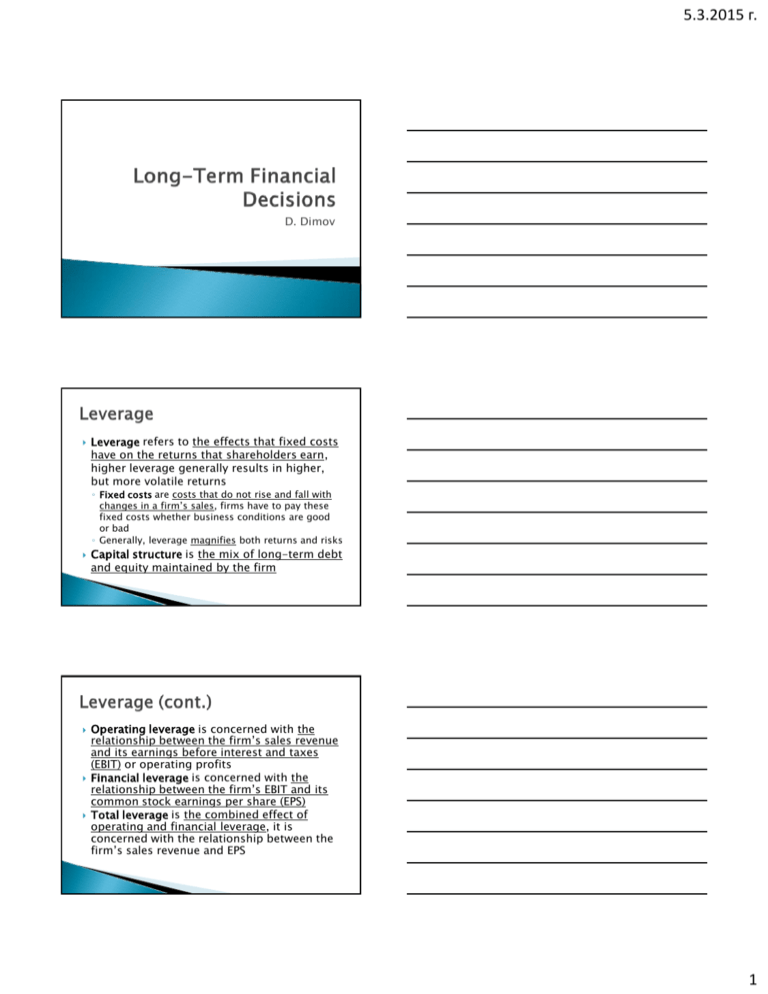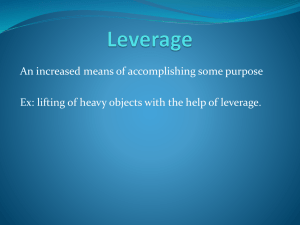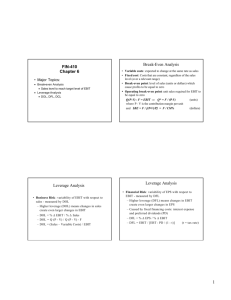Long term financial decisions
advertisement

5.3.2015 г. D. Dimov Leverage refers to the effects that fixed costs have on the returns that shareholders earn, higher leverage generally results in higher, but more volatile returns ◦ Fixed costs are costs that do not rise and fall with changes in a firm’s sales, firms have to pay these fixed costs whether business conditions are good or bad ◦ Generally, leverage magnifies both returns and risks Capital structure is the mix of long-term debt and equity maintained by the firm Operating leverage is concerned with the relationship between the firm’s sales revenue and its earnings before interest and taxes (EBIT) or operating profits Financial leverage is concerned with the relationship between the firm’s EBIT and its common stock earnings per share (EPS) Total leverage is the combined effect of operating and financial leverage, it is concerned with the relationship between the firm’s sales revenue and EPS 1 5.3.2015 г. Breakeven analysis is used to indicate the level of operations necessary to cover all costs and to evaluate the profitability associated with various levels of sales, also called cost-volume-profit analysis The operating breakeven point is the level of sales necessary to cover all operating costs, the point at which EBIT = $0 ◦ The first step in finding the operating breakeven point is to divide the cost of goods sold and operating expenses into fixed and variable operating costs ◦ Fixed costs are costs that the firm must pay in a given period regardless of the sales volume achieved during that period ◦ Variable costs vary directly with sales volume 2 5.3.2015 г. Rewriting the algebraic calculations in Table 13.2 as a formula for earnings before interest and taxes yields: EBIT = (P x Q) – FC – (VC x Q) Simplifying yields: EBIT = Q x (P – VC) – FC Setting EBIT equal to $0 and solving for Q (the firm’s breakeven point) yields: Assume that Cheryl’s Posters, a small poster retailer, has fixed operating costs of $2,500, its sale price is $10 per poster, and its variable operating cost is $5 per poster What is the firm’s breakeven point? 3 5.3.2015 г. Assume that Cheryl’s Posters wishes to evaluate the impact of several options: (1) increasing fixed operating costs to $3,000, (2) increasing the sale price per unit to $12.50, (3) increasing the variable operating cost per unit to $7.50, and (4) simultaneously implementing all three of these changes ◦ ◦ ◦ ◦ 1. Operating breakeven point = 2. Operating breakeven point = 3. Operating breakeven point = 4. Operating breakeven point = $3,000/($10 – $5) = 600 units $2,500/($12.50 – $5) = 333 units $2,500/($10 – $7.50) = 1,000 units $3,000/($12.50 – $7.50) = 600 units Operating leverage is the use of fixed operating costs to magnify the effects of changes in sales on the firm’s earnings before interest and taxes The figure on the next slide uses the data for Cheryl’s Posters (sale price, P = $10 per unit, variable operating cost, VC = $5 per unit, fixed operating cost, FC = $2,500) 4 5.3.2015 г. The degree of operating leverage (DOL) is the numerical measure of the firm’s operating leverage As long as DOL is greater than 1, there is operating leverage 5 5.3.2015 г. Applying the degree of operating leverage equation to cases 1 and 2 in Table 13.4 yields the following results: A more direct formula for calculating the degree of operating leverage at a base sales level (Q) is the following: Substituting Q = 1,000, P = $10, VC = $5, and FC = $2,500 into the above equation yields the following result: Adobe’s Leverage ◦ Adobe Systems, the second largest PC software company in the United States, dominates the graphic design, imaging, dynamic media, and authoring-tool software markets ◦ As demonstrated in the following table, operating leverage magnified Adobe’s increase in EBIT in 2007 while magnifying the decrease in EBIT in 2009 ◦ A 22.6% increase in 2007 sales resulted in EBIT growth of 39.7% ◦ In 2008, EBIT increased just a little faster than sales did, but in 2009 as the economy endured a severe recession, Adobe revenues plunged 17.7%; the effect of operating leverage was that EBIT declined even faster, posting a – 35.3% drop 6 5.3.2015 г. Adobe’s Leverage Assume that Cheryl’s Posters exchanges a portion of its variable operating costs for fixed operating costs by eliminating sales commissions and increasing sales salaries; this exchange results in a reduction in the variable operating cost per unit from $5 to $4.50 and an increase in the fixed operating costs from $2,500 to $3,000 7 5.3.2015 г. Financial leverage is the use of fixed financial costs to magnify the effects of changes in earnings before interest and taxes on the firm’s earnings per share The two most common fixed financial costs are (1) interest on debt and (2) preferred stock dividends Chen Foods, a small Asian food company, expects EBIT of $10,000 in the current year, it has a $20,000 bond with a 10% (annual) coupon rate of interest and an issue of 600 shares of $4 (annual dividend per share) preferred stock outstanding, it also has 1,000 shares of common stock outstanding, the annual interest on the bond issue is $2,000 (0.10 x $20,000), the annual dividends on the preferred stock are $2,400 ($4.00/share x 600 shares) 8 5.3.2015 г. The degree of financial leverage (DFL) is the numerical measure of the firm’s financial leverage Whenever DFL is greater than 1, there is financial leverage Applying the degree of financial leverage equation to cases 1 and 2 in Table 13.6 yields the following results: A more direct formula for calculating the degree of financial leverage at a base level of EBIT is the following: Note that in the denominator, the term 1/(1 – T) converts the after-tax preferred stock dividend to a before-tax amount for consistency with the other terms in the equation 9 5.3.2015 г. Substituting EBIT = $10,000, I = $2,000, PD = $2,400, and the tax rate (T = 0.40) into the previous equation yields: Total leverage is the use of fixed costs, both operating and financial, to magnify the effects of changes in sales on the firm’s earnings per share Cables Inc., a computer cable manufacturer, expects sales of 20,000 units at $5 per unit in the coming year and must meet the following obligations: variable operating costs of $2 per unit, fixed operating costs of $10,000, interest of $20,000, and preferred stock dividends of $12,000; the firm is in the 40% tax bracket and has 5,000 shares of common stock outstanding 10 5.3.2015 г. The degree of total leverage (DTL) is the numerical measure of the firm’s total leverage As long as the DTL is greater than 1, there is total leverage Applying the degree of total leverage equation to the data in Table 13.7 yields the following: 11 5.3.2015 г. A more direct formula for calculating the degree of total leverage at a given base level of sales (Q) is given by the following equation: Substituting Q = 20,000, P = $5, VC = $2, FC = $10,000, I = $20,000, PD = $12,000, and the tax rate T = 0.40 into the previous equation yields: Total leverage reflects the combined impact of operating and financial leverage on the firm High operating leverage and high financial leverage will cause total leverage to be high, the opposite will also be true The relationship between operating leverage and financial leverage is multiplicative rather than additive: DTL = DOL x DFL 12 5.3.2015 г. Substituting the values calculated for DOL and DFL, shown on the right-hand side of Table 13.7, into the previous equation yields DTL = 1.2 x 5.0 = 6.0 All of the items on the right-hand side of the firm’s balance sheet, excluding current liabilities, are sources of capital, the following simplified balance sheet illustrates the basic breakdown of total capital into its two components, debt capital and equity capital The cost of debt is lower than the cost of other forms of financing Lenders demand relatively lower returns because they take the least risk of any contributors of long-term capital Lenders have a higher priority of claim against any earnings or assets available for payment, and they can exert far greater legal pressure against the company to make payment than can owners of preferred or common stock The tax deductibility of interest payments also lowers the debt cost to the firm substantially 13 5.3.2015 г. Unlike debt capital, which the firm must eventually repay, equity capital remains invested in the firm indefinitely—it has no maturity date The two basic sources of equity capital are (1) preferred stock and (2) common stock equity, which includes common stock and retained earnings Common stock is typically the most expensive form of equity, followed by retained earnings and then preferred stock Whether the firm borrows very little or a great deal, it is always true that the claims of common stockholders are riskier than those of lenders, so the cost of equity always exceeds the cost of debt A direct measure of the degree of indebtedness is the debt ratio (total liabilities ÷ total assets) and the higher this ratio is, the greater the relative amount of debt (or financial leverage) in the firm’s capital structure Measures of the firm’s ability to meet contractual payments associated with debt include the times interest earned ratio (EBIT ÷ interest) The level of debt (financial leverage) that is acceptable for one industry or line of business can be highly risky in another, because different industries and lines of business have different operating characteristics 14 5.3.2015 г. Research suggests that there is an optimal capital structure range It is not yet possible to provide financial managers with a precise methodology for determining a firm’s optimal capital structure Nevertheless, financial theory does offer help in understanding how a firm’s capital structure affects the firm’s value Many researchers, have examined the effects of less restrictive assumptions on the relationship between capital structure and the firm’s value and the result is a theoretical optimal capital structure based on balancing the benefits and costs of debt financing: ◦ The major benefit of debt financing is the tax shield, which allows interest payments to be deducted in calculating taxable income ◦ The cost of debt financing results from (1) the increased probability of bankruptcy caused by debt obligations, (2) the agency costs of the lender’s constraining the firm’s actions, and (3) the costs associated with managers having more information about the firm’s prospects than do investors Tax benefits ◦ Allowing firms to deduct interest payments on debt when calculating taxable income reduces the amount of the firm’s earnings paid in taxes, thereby making more earnings available for bondholders and stockholders ◦ The deductibility of interest means the cost of debt (ri) to the firm is subsidized by the government ◦ Letting rd equal the before-tax cost of debt and letting T equal the tax rate, we have ri = rd x (1 – T) 15 5.3.2015 г. Probability of bankruptcy Probability of bankruptcy ◦ The chance that a firm will become bankrupt because of an inability to meet its obligations as they come due depends largely on its level of both business risk and financial risk ◦ Business risk is the risk to the firm of being unable to cover its operating costs ◦ In general, the greater the firm’s operating leverage—the use of fixed operating costs—the higher its business risk ◦ Although operating leverage is an important factor affecting business risk, two other factors—revenue stability and cost stability—also affect it ◦ Firms with high business risk therefore tend toward less highly leveraged capital structures, and firms with low business risk tend toward more highly leveraged capital structures ◦ The firm’s capital structure directly affects its financial risk, which is the risk to the firm of being unable to cover required financial obligations ◦ The penalty for not meeting financial obligations is bankruptcy ◦ The more fixed-cost financing—debt (including financial leases) and preferred stock—a firm has in its capital structure, the greater its financial leverage and risk ◦ The total risk of a firm—business and financial risk combined—determines its probability of bankruptcy Agency costs imposed by lenders ◦ The managers of firms typically act as agents of the owners (stockholders) ◦ The owners give the managers the authority to manage the firm for the owners’ benefit ◦ The agency problem created by this relationship extends not only to the relationship between owners and managers but also to the relationship between owners and lenders ◦ To avoid this situation, lenders impose certain monitoring techniques on borrowers, who as a result incur agency costs 16 5.3.2015 г. Asymmetric information ◦ Asymmetric information is the situation in which managers of a firm have more information about operations and future prospects than do investors ◦ A pecking order is a hierarchy of financing that begins with retained earnings, which is followed by debt financing and finally external equity financing ◦ A signal is a financing action by management that is believed to reflect its view of the firm’s stock value, generally, debt financing is viewed as a positive signal that management believes the stock is “undervalued,” and a stock issue is viewed as a negative signal that management believes the stock is “overvalued” What, then, is the optimal capital structure, even if it exists (so far) only in theory? Because the value of a firm equals the present value of its future cash flows, it follows that the value of the firm is maximized when the cost of capital is minimized where EBIT = earnings before interest and taxes T = tax rate NOPAT = net operating profits after taxes, which is the after-tax operating earnings available to the debt and equity holders or EBIT x (1 – T) ra = weighted average cost of capital The EBIT–EPS approach is an approach for selecting the capital structure that maximizes earnings per share (EPS) over the expected range of earnings before interest and taxes (EBIT) We can plot coordinates on the EBIT–EPS graph by assuming specific EBIT values and calculating the EPS associated with them The calculations for EPS for three capital structures or debt ratios of 0%, 30%, and 60% and for two EBIT values of $100,000 and $200,000 for Cooke Company are summarized on the next slide in Figure 13.6 17 5.3.2015 г. When interpreting EBIT–EPS analysis, it is important to consider the risk of each capital structure alternative Graphically, the risk of each capital structure can be viewed in light of two measures: ◦ The financial breakeven point (EBIT-axis intercept) ◦ The degree of financial leverage reflected in the slope of the capital structure line ◦ The higher the financial breakeven point and the steeper the slope of the capital structure line, the greater the financial risk The most important point to recognize when using EBIT–EPS analysis is that this technique tends to concentrate on maximizing earnings rather than maximizing owner wealth as reflected in the firm’s stock price The use of an EPS-maximizing approach generally ignores risk Because risk premiums increase with increases in financial leverage, the maximization of EPS does not ensure owner wealth maximization 18 5.3.2015 г. To determine the firm’s value under alternative capital structures, the firm must find the level of return that it must earn to compensate owners for the risk being incurred The required return associated with a given level of financial risk can be estimated in a number of ways: ◦ Theoretically, the preferred approach would be first to estimate the beta associated with each alternative capital structure and then to use the CAPM framework to calculate the required return (rs) ◦ A more operational approach involves linking the financial risk associated with each capital structure alternative directly to the required return The value of the firm associated with alternative capital structures can be estimated by using one of the standard valuation models, such as the zero-growth model Although some relationship exists between expected profit and value, there is no reason to believe that profit maximizing strategies necessarily result in wealth maximization It is therefore the wealth of the owners as reflected in the estimated share value that should serve as the criterion for selecting the best capital structure 19 5.3.2015 г. 20





